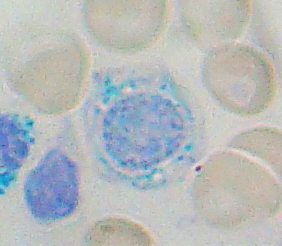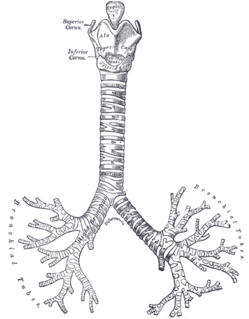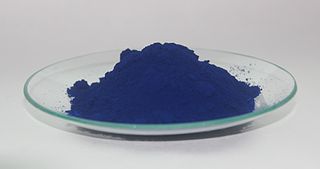
Cyan is a greenish-blue color. It is evoked by light with a predominant wavelength of between 490–520 nm, between the wavelengths of green and blue.
Dual or Duals may refer to:

Heinrich Hermann Robert Koch was a German physician and microbiologist. As one of the main founders of modern bacteriology, he identified the specific causative agents of tuberculosis, cholera, and anthrax and also gave experimental support for the concept of infectious disease, which included experiments on humans and animals. Koch created and improved laboratory technologies and techniques in the field of microbiology, and made key discoveries in public health. His research led to the creation of Koch's postulates, a series of four generalized principles linking specific microorganisms to specific diseases that proved influential on subsequent epidemiological principles such as the Bradford Hill criteria. For his research on tuberculosis, Koch received the Nobel Prize in Physiology or Medicine in 1905. The Robert Koch Institute is named in his honour.

Pathology is the study of the causes and effects of disease or injury. The word pathology also refers to the study of disease in general, incorporating a wide range of bioscience research fields and medical practices. However, when used in the context of modern medical treatment, the term is often used in a more narrow fashion to refer to processes and tests which fall within the contemporary medical field of "general pathology", an area which includes a number of distinct but inter-related medical specialties that diagnose disease, mostly through analysis of tissue, cell, and body fluid samples. Idiomatically, "a pathology" may also refer to the predicted or actual progression of particular diseases, and the affix pathy is sometimes used to indicate a state of disease in cases of both physical ailment and psychological conditions. A physician practicing pathology is called a pathologist.
Plague or The Plague may refer to:
Prussian blue is a dark blue pigment produced by oxidation of ferrous ferrocyanide salts. It has the chemical formula FeIII
4[FeII
(CN)
6]
3. Another name for the color is Berlin blue or, in painting, Parisian or Paris blue. Turnbull's blue is the same substance, but is made from different reagents, and its slightly different color stems from different impurities.
Engineer's blue is a highly pigmented paste used to assist in the mating of two or more components.

Modern Talking was a German duo consisting of singer Thomas Anders and arranger, songwriter and producer Dieter Bohlen, with the participation of Luis Rodríguez in the production. They have been referred to as Germany's most successful pop duo, and have had a number of hit singles, reaching the top five in many countries. Some of their most popular and widely known singles are "You're My Heart, You're My Soul", "You Can Win If You Want", "Cheri, Cheri Lady", "Brother Louie", "Atlantis Is Calling " and "Geronimo's Cadillac".

Histopathology refers to the microscopic examination of tissue in order to study the manifestations of disease. Specifically, in clinical medicine, histopathology refers to the examination of a biopsy or surgical specimen by a pathologist, after the specimen has been processed and histological sections have been placed onto glass slides. In contrast, cytopathology examines free cells or tissue micro-fragments.
In medicine, a differential diagnosis is the distinguishing of a particular disease or condition from others that present similar clinical features. Differential diagnostic procedures are used by physicians to diagnose the specific disease in a patient, or, at least, to eliminate any imminently life-threatening conditions. Often, each individual option of a possible disease is called a differential diagnosis.

Midnight blue is a dark shade of blue named for its resemblance to the apparently blue color of a moonlit night sky around full moon. Midnight blue is the color of a vat full of indigo dye; therefore, midnight blue may also be considered a dark shade of indigo. Midnight blue is identifiably blue to the eye in sunlight or full-spectrum light, but can appear black under certain more limited spectra sometimes found in artificial lighting. It is similar to navy, which is also a dark blue.

Periodic acid–Schiff (PAS) is a staining method used to detect polysaccharides such as glycogen, and mucosubstances such as glycoproteins, glycolipids and mucins in tissues. The reaction of periodic acid oxidizes the vicinal diols in these sugars, usually breaking up the bond between two adjacent carbons not involved in the glycosidic linkage or ring closure in the ring of the monosaccharide units that are parts of the long polysaccharides, and creating a pair of aldehydes at the two free tips of each broken monosaccharide ring. The oxidation condition has to be sufficiently regulated so as to not oxidize the aldehydes further. These aldehydes then react with the Schiff reagent to give a purple-magenta color. A suitable basic stain is often used as a counterstain.

Sideroblastic anemia, or sideroachrestic anemia, is a form of anemia in which the bone marrow produces ringed sideroblasts rather than healthy red blood cells (erythrocytes). In sideroblastic anemia, the body has iron available but cannot incorporate it into hemoglobin, which red blood cells need in order to transport oxygen efficiently. The disorder may be caused either by a genetic disorder or indirectly as part of myelodysplastic syndrome, which can develop into hematological malignancies.
Prussian Blue was an American white nationalist, Neo-Nazi pop duo formed of Lynx Vaughan Gaede and Lamb Lennon Gaede, fraternal twins born on June 30, 1992, in Bakersfield, California. The duo Prussian Blue was formed in early 2003 by their mother April Gaede, who now goes by April Harrington. The twins referred to the Holocaust as a myth and promoted Holocaust denial and their group was described as racist and white supremacist.
Blue Light or Blue light may refer to:

Bronchophony is the abnormal transmission of sounds from the lungs or bronchi. Bronchophony is a type of pectoriloquy.

Human feces are the solid or semisolid remains of food that could not be digested or absorbed in the small intestine of humans, but has been rotted down by bacteria in the large intestine. It also contains bacteria and a relatively small amount of metabolic waste products such as bacterially altered bilirubin, and the dead epithelial cells from the lining of the gut. It is discharged through the anus during a process called defecation.
Diagnosis is the identification of the nature and cause of a certain phenomenon. Diagnosis is used in many different disciplines, with variations in the use of logic, analytics, and experience, to determine "cause and effect". In systems engineering and computer science, it is typically used to determine the causes of symptoms, mitigations, and solutions.

Medical diagnosis is the process of determining which disease or condition explains a person's symptoms and signs. It is most often referred to as diagnosis with the medical context being implicit. The information required for diagnosis is typically collected from a history and physical examination of the person seeking medical care. Often, one or more diagnostic procedures, such as medical tests, are also done during the process. Sometimes posthumous diagnosis is considered a kind of medical diagnosis.

Prussian blue, also known as potassium ferric hexacyanoferrate, is used as a medication to treat thallium poisoning or radioactive cesium poisoning. For thallium it may be used in addition to gastric lavage, activated charcoal, forced diuresis, and hemodialysis. It is given by mouth or nasogastric tube. Prussian blue is also used in the urine to test for G6PD deficiency.










